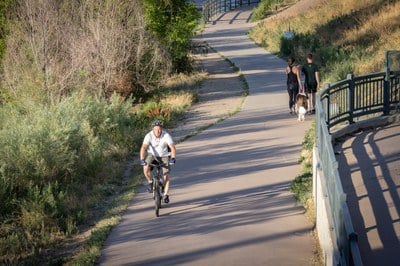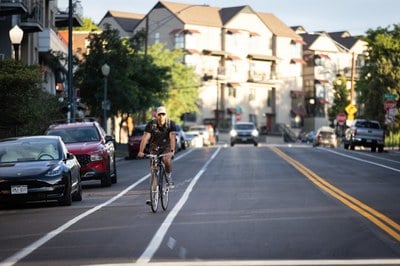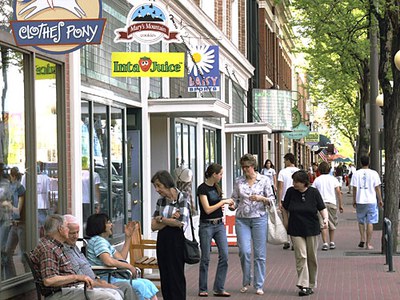Statewide Active Transportation Plan
Why This Plan Matters
CDOT’s Statewide Active Transportation Plan (ATP) lays out a vision for making it easier, safer, and more comfortable for people to walk, bike, and roll throughout Colorado — whether for commuting, running errands, or just enjoying the outdoors. The plan builds on the growing momentum around walking and biking by setting statewide goals, strategies, and policy recommendations to guide improvements over the coming years.
Because the demand for safe and accessible walking and biking infrastructure is greater than the available funding, the plan also includes an interactive map-based tool that helps identify where active transportation improvements are most needed and where they can make the biggest difference.
The plan works alongside other major statewide efforts — like the Statewide Transportation Plan, the Strategic Transportation Safety Plan, and the Governor’s Colorado Transportation Vision 2035 — to make sure walking and biking are included in big-picture transportation decisions. By coordinating with these efforts, CDOT ensures that active transportation is part of the broader conversation about improving mobility, safety, equity, sustainability, and accessibility across the state.
What is Active Transportation?
 Active transportation is any human-scale and typically human-powered mode of transportation, such as walking, running, bicycling, roller blading, or using an electric bicycle, kick scooter or electric scooter, skateboard, wheelchair, or other personal assistive mobility device.
Active transportation is any human-scale and typically human-powered mode of transportation, such as walking, running, bicycling, roller blading, or using an electric bicycle, kick scooter or electric scooter, skateboard, wheelchair, or other personal assistive mobility device.
Why Invest in Active Transportation?
Safety
Bicyclists and pedestrians are highly overrepresented in severe crashes compared to all crashes – accounting for 17.7% of all fatality and serious injury crashes and only 2.6% of all traffic crashes in Colorado. Traffic-related fatalities and serious injuries involving these vulnerable road users have surged by 144% over the past decade, resulting in hundreds of serious injuries and fatalities annually.
Sustainability
Greater adoption of zero-emission travel modes like biking, walking, and rolling is a key strategy in achieving the greenhouse gas (GHG) emissions reductions as outlined in the state’s GHG Pollution Reduction Roadmap and CDOT’s GHG Planning Standard.
Economic Vitality
Active transportation is a major driver of economic activity locally and statewide – it contributes hundreds of millions of dollars annually to our economy.
 Equity & Affordability
Equity & Affordability
Improvements to the active transportation network can help address health and safety inequities by providing safe and affordable transportation options in communities that have historically been marginalized in transportation planning efforts.
Public Health
Robust active transportation networks help people incorporate physical activity into their daily lives by allowing them to walk, bike, or roll to get where they need to go.
Learn more about the benefits and importance of active transportation investment in the draft Active Transportation Plan.
Vision and Goals
Vision
Colorado’s active transportation network is well-connected, comprehensive, and convenient – our bikeways, sidewalks, and trails get people where they want to go. This system offers everyone the opportunity to safely and confidently rely on or choose active modes over driving, in turn improving transportation sustainability, reducing car dependency, and mitigating traffic congestion. Enhancing our active transportation network will enhance quality of life for all Coloradoans.
Goals
Safety
Enhance the safety of active transportation users by reducing crashes, injuries, and fatalities.
Equity

Ensure equitable access to safe and convenient active transportation facilities for all communities, particularly underserved and vulnerable populations.
Mobility Choice
Increase the availability, accessibility, and convenience of active transportation to create a complete network that provides sustainable and affordable alternatives to driving and improves air quality.
Connected Communities
Promote connections among active transportation, transit, and the built environment to maximize the impact of investments in active transportation infrastructure and programs.
Planning Process
The ATP was developed through a robust stakeholder process held throughout 2024 and 2025. Multiple CDOT divisions collaborated with local governments, regional planning partners, state and federal agencies, advocacy organizations, and community members to shape the plan’s vision, goals, and strategies. A Community Advisory Committee made up of representatives from dozens of agencies and organizations across the state provided valuable input on draft plan elements and helped ensure local and regional perspectives were reflected.
Public input also played a key role. More than 3,000 Coloradans responded to an online survey that asked about their travel habits, barriers to walking and biking, preferences on different types of infrastructure, and what they see as the biggest benefits of investing in active transportation. This feedback directly informed the development of the plan’s vision, goals, and strategies.

This stakeholder and public engagement process informed the development of a robust map-based analysis tool, the Priority Active Connections Explorer (PACE), which will support ongoing prioritization and implementation of active transportation projects.
Get Involved!
A draft of the Active Transportation Plan is now complete and was available for public review and comments from June 12 to July 18, 2025. During that time, we received over 200 comments from across Colorado. While we are no longer accepting comments, you may still download and review the draft plan by clicking the link below. We are currently working to finalize the plan. The final approved plan will be posted here in September.
